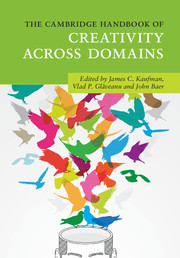Book contents
- The Cambridge Handbook of Creativity Across Domains
- The Cambridge Handbook of Creativity Across Domains
- Copyright page
- Dedication
- Contents
- Figures
- Tables
- Contributors
- Acknowledgments
- Part I Creativity and Domain
- Part II Creativity in the Traditional Arts
- 5 The Creativity of Literary Writing
- 6 Creativity in the Visual Arts
- 7 The Creation and Aesthetic Appreciation of Architecture
- 8 Photography and Creativity
- 9 The Constricted Muse
- 10 Musical Creativity
- 11 Dance
- Part III Creativity in the Sciences
- Part IV Creativity in Business
- Part V Newer Domains for Creativity Research
- Part VI Creativity in Everyday Life
- Part VII Conclusion
- Index
- References
8 - Photography and Creativity
from Part II - Creativity in the Traditional Arts
Published online by Cambridge University Press: 15 September 2017
- The Cambridge Handbook of Creativity Across Domains
- The Cambridge Handbook of Creativity Across Domains
- Copyright page
- Dedication
- Contents
- Figures
- Tables
- Contributors
- Acknowledgments
- Part I Creativity and Domain
- Part II Creativity in the Traditional Arts
- 5 The Creativity of Literary Writing
- 6 Creativity in the Visual Arts
- 7 The Creation and Aesthetic Appreciation of Architecture
- 8 Photography and Creativity
- 9 The Constricted Muse
- 10 Musical Creativity
- 11 Dance
- Part III Creativity in the Sciences
- Part IV Creativity in Business
- Part V Newer Domains for Creativity Research
- Part VI Creativity in Everyday Life
- Part VII Conclusion
- Index
- References
Summary
This chapter reviews some aspects of creativity that are common to many artistic domains and particularly aspects that are distinctive about photography (e.g., the violence/entrapment metaphor, the role of timing and light, the issue of whether photography is merely a reproduction of reality with minimal creativity). Although photographers typically do not concern themselves with definitions of creativity, many have offered suggestions on how to judge photographic creativity which aids the measurement process. In this chapter we cover creativity in photography based on three different perspectives: (1) creative photographs, (2) expertise in creative photography, and (3) creative personality as studied through photographic autoportraits and photo essays. Consistent with the expansion of the literature, the rapid growth of digital technology suggests that this domain of creativity is entering its golden age.
- Type
- Chapter
- Information
- The Cambridge Handbook of Creativity across Domains , pp. 123 - 144Publisher: Cambridge University PressPrint publication year: 2017
References
- 1
- Cited by



